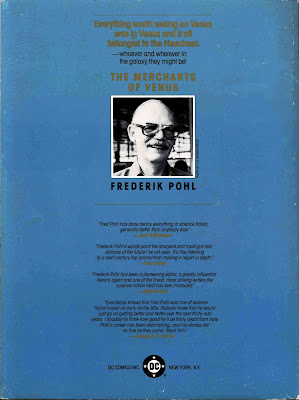The Merchants of Venus
by Frederik Pohl
DC Comics Science Fiction Graphic Novel No. 4
January, 1986
'The Merchants of Venus' was issued in 1986 as one of the entries in DC Comics' 'Science Fiction Graphic Novel' catalog. The writers are Victoria Petersen and Neal McPheeters, with art by McPheeters.
'Merchants' first was published as a novelette in August, 1972 in Worlds of If.
Protagonist Audee Walthers lives on, or rather, in Venus, in the Spindle, an immense underground cavern excavated by the since-vanished race of aliens known as the Heechee. Walthers makes a modest living by transporting tourists around Venus in his aircar.
There's not much to see on the surface of Venus, but Walthers specializes in bringing his clients to see the engineering works left by the Heechee, including the underground tunnels where, sometimes, scavengers have come across valuable and precious artifacts.
Needing money, and lots of it, Walthers is intrigued when a wealthy Terran couple, Boyce Cochenour, and his stunning mistress Dorotha Keefer, arrive at the Spindle looking for adventure and excitement. Walthers convinces them that he can take them to places on-planet where there might yet be undiscovered Heechee warrens, and in those warrens, treasure.
Stuffing Walthers' aircar with gear and provisions, the trio set off. For Cochenour and Keefer, Venus turns out to be quite dangerous and unpleasant, but the lure of wealth overrides their concerns. For his part, Walther has his own - rather selfish - motives for wanting to find a cache of Heechee technology.
As the plot progresses it turns out Walthers isn't the only one with secrets and ulterior motives. Can he and his charges put aside their tensions long enough to find that one site where some digging might yield an undiscovered Heechee stash ?
I admit I had low expectations when I picked up 'Merchants,' mainly because I find Pohl to be an underwhelming author, and the bright, primary color scheme of the book gave it a cartoony aspect. But it turns out that 'Merchants' has a decent, very readable hard-sf story, one where you're kept guessing until the very last page.
I admit I had low expectations when I picked up 'Merchants,' mainly because I find Pohl to be an underwhelming author, and the bright, primary color scheme of the book gave it a cartoony aspect. But it turns out that 'Merchants' has a decent, very readable hard-sf story, one where you're kept guessing until the very last page.
Summing up, you don't have to be a Pohl fan to appreciate this book. With copies going for $10 for a Very Good grading, I was fortunate to pick this up for $5. If you can find it for a reasonable price, you may want to get one yourself............



















































































